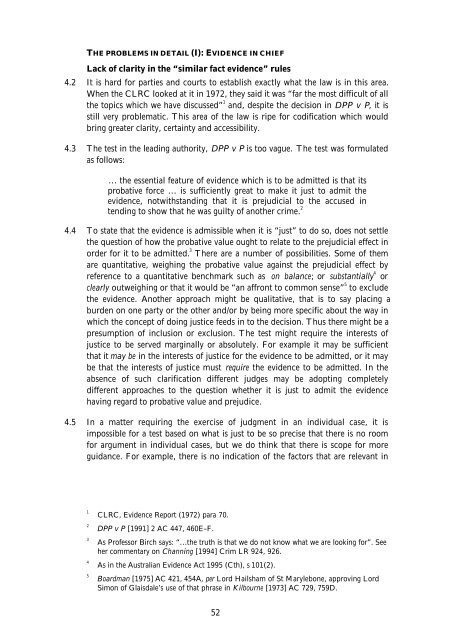Evidence of Bad Character in Criminal ... - Law Commission
Evidence of Bad Character in Criminal ... - Law Commission
Evidence of Bad Character in Criminal ... - Law Commission
Create successful ePaper yourself
Turn your PDF publications into a flip-book with our unique Google optimized e-Paper software.
THE PROBLEMS IN DETAIL (I): EVIDENCE IN CHIEF<br />
Lack <strong>of</strong> clarity <strong>in</strong> the “similar fact evidence” rules<br />
4.2 It is hard for parties and courts to establish exactly what the law is <strong>in</strong> this area.<br />
When the CLRC looked at it <strong>in</strong> 1972, they said it was “far the most difficult <strong>of</strong> all<br />
the topics which we have discussed” 1 and, despite the decision <strong>in</strong> DPP v P, it is<br />
still very problematic. This area <strong>of</strong> the law is ripe for codification which would<br />
br<strong>in</strong>g greater clarity, certa<strong>in</strong>ty and accessibility.<br />
4.3 The test <strong>in</strong> the lead<strong>in</strong>g authority, DPP v P is too vague. The test was formulated<br />
as follows:<br />
… the essential feature <strong>of</strong> evidence which is to be admitted is that its<br />
probative force … is sufficiently great to make it just to admit the<br />
evidence, notwithstand<strong>in</strong>g that it is prejudicial to the accused <strong>in</strong><br />
tend<strong>in</strong>g to show that he was guilty <strong>of</strong> another crime. 2<br />
4.4 To state that the evidence is admissible when it is “just” to do so, does not settle<br />
the question <strong>of</strong> how the probative value ought to relate to the prejudicial effect <strong>in</strong><br />
order for it to be admitted. 3 There are a number <strong>of</strong> possibilities. Some <strong>of</strong> them<br />
are quantitative, weigh<strong>in</strong>g the probative value aga<strong>in</strong>st the prejudicial effect by<br />
reference to a quantitative benchmark such as on balance; or substantially 4 or<br />
clearly outweigh<strong>in</strong>g or that it would be “an affront to common sense” 5 to exclude<br />
the evidence. Another approach might be qualitative, that is to say plac<strong>in</strong>g a<br />
burden on one party or the other and/or by be<strong>in</strong>g more specific about the way <strong>in</strong><br />
which the concept <strong>of</strong> do<strong>in</strong>g justice feeds <strong>in</strong> to the decision. Thus there might be a<br />
presumption <strong>of</strong> <strong>in</strong>clusion or exclusion. The test might require the <strong>in</strong>terests <strong>of</strong><br />
justice to be served marg<strong>in</strong>ally or absolutely. For example it may be sufficient<br />
that it may be <strong>in</strong> the <strong>in</strong>terests <strong>of</strong> justice for the evidence to be admitted, or it may<br />
be that the <strong>in</strong>terests <strong>of</strong> justice must require the evidence to be admitted. In the<br />
absence <strong>of</strong> such clarification different judges may be adopt<strong>in</strong>g completely<br />
different approaches to the question whether it is just to admit the evidence<br />
hav<strong>in</strong>g regard to probative value and prejudice.<br />
4.5 In a matter requir<strong>in</strong>g the exercise <strong>of</strong> judgment <strong>in</strong> an <strong>in</strong>dividual case, it is<br />
impossible for a test based on what is just to be so precise that there is no room<br />
for argument <strong>in</strong> <strong>in</strong>dividual cases, but we do th<strong>in</strong>k that there is scope for more<br />
guidance. For example, there is no <strong>in</strong>dication <strong>of</strong> the factors that are relevant <strong>in</strong><br />
1 CLRC, <strong>Evidence</strong> Report (1972) para 70.<br />
2 DPP v P [1991] 2 AC 447, 460E–F.<br />
3 As Pr<strong>of</strong>essor Birch says: “…the truth is that we do not know what we are look<strong>in</strong>g for”. See<br />
her commentary on Chann<strong>in</strong>g [1994] Crim LR 924, 926.<br />
4 As <strong>in</strong> the Australian <strong>Evidence</strong> Act 1995 (Cth), s 101(2).<br />
5 Boardman [1975] AC 421, 454A, per Lord Hailsham <strong>of</strong> St Marylebone, approv<strong>in</strong>g Lord<br />
Simon <strong>of</strong> Glaisdale’s use <strong>of</strong> that phrase <strong>in</strong> Kilbourne [1973] AC 729, 759D.<br />
52

















